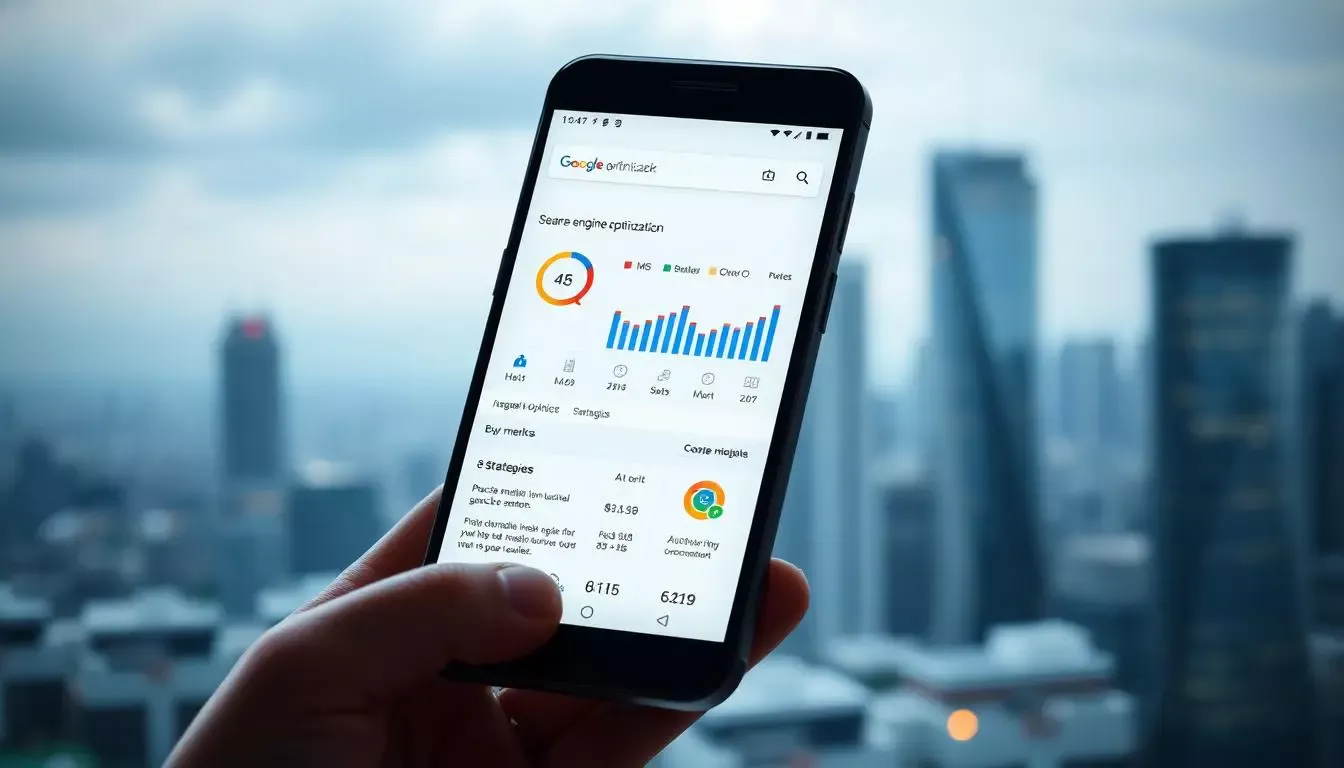In today’s world, 60% of internet users access websites through mobile devices. This makes it key for businesses to focus on mobile-friendly SEO. With most searches happening on smartphones, having a website that works well on mobile is essential.
A website that works well on mobile devices boosts user experience and search rankings. Knowing how to optimize for Google Mobile SEO is critical for businesses to stay competitive online.
Key Takeaways
- Mobile optimization is key for website visibility.
- A mobile-friendly website improves user experience and search rankings.
- Understanding Google Mobile SEO is vital for businesses.
- Mobile SEO strategies can drive more traffic to your website.
- A well-optimized website is essential for staying competitive online.
The Mobile-First Era of Search
Searching online has changed a lot with the rise of mobile devices. Google now favors mobile-friendly websites. This makes mobile optimization key for businesses to keep up.
The Shift to Mobile Internet Usage
More people use the internet on mobiles than on computers. Most Google searches come from mobiles. This change means businesses must focus on mobile SEO strategies to be seen.
Why Mobile Optimization Is No Longer Optional
Websites not optimized for mobiles will rank lower in Google’s mobile-first indexing. Important mobile optimization includes:
- Responsive web design
- Fast page loading speeds
- Easy navigation on smaller screens
How Mobile Search Behavior Differs from Desktop
Mobile searches are often shorter and focus on local search results. Knowing these differences helps businesses tailor their SEO.
Adapting to the mobile-first era helps businesses improve their online presence. This keeps them competitive.
Google’s Mobile-First Indexing Explained
Understanding Google’s mobile-first indexing is key for today’s SEO. Most people use mobile devices to surf the web. So, Google now focuses on mobile-friendly content.
What Is Mobile-First Indexing?
Mobile-first indexing means Google uses the mobile version of a website first. This change is because more people search on mobiles. Neil Patel says it’s essential for businesses to keep up in search rankings.
How Google Crawls and Indexes Mobile Sites
Google’s process for mobile sites includes several steps. First, Googlebot checks the mobile version of a site. It looks at content, structure, and user experience.
Then, Google indexes this content. It considers page speed, how well the site responds, and if there are intrusive ads.
Timeline of Google’s Mobile-First Implementation
Google started moving to mobile-first indexing in 2018. The change happened gradually, affecting different sites and industries at different times. Some sites were switched as early as 2019, while others were later.
Key Algorithm Updates Affecting Mobile Rankings
Several updates have changed how mobile sites rank. The Mobile-Friendly Update and the Speed Update are key. They highlight the need for good mobile usability and fast page loads.
Current State of Mobile Indexing
Now, most websites are indexed using mobile-first indexing. Google keeps updating its indexing to match user behavior and tech changes.
| Aspect | Desktop Indexing | Mobile-First Indexing |
|---|---|---|
| Crawling | Primarily crawls desktop version | Crawls mobile version |
| Indexing | Indexes desktop content | Indexes mobile content |
| Ranking | Desktop content influences rankings | Mobile content influences rankings |
Google says mobile-first indexing is about great user experience on all devices. It’s not just about having a mobile-friendly site. It’s about making sure content works well on mobiles.
“The mobile-first indexing paradigm is not just about having a mobile-friendly site; it’s about creating a great user experience across all devices.”
Core Google Mobile SEO Strategies
In today’s mobile-first world, having the right Google Mobile SEO strategies is key. As search engines focus more on mobile-friendly sites, businesses must keep up to stay ahead.
Responsive Web Design Implementation
A responsive web design is essential for Google Mobile SEO success. It makes sure your site works well on all devices and screen sizes. Here’s how to make your site responsive:
- Use flexible grids and layouts
- Optimize images for different screen sizes
- Ensure touch-friendly navigation elements
Mobile Page Speed Optimization
Mobile page speed is important for Google rankings. To speed up your site, focus on these areas:
Core Web Vitals for Mobile
- Improving Largest Contentful Paint (LCP)
- Enhancing First Input Delay (FID)
- Cumulative Layout Shift (CLS) optimization
Image and Resource Optimization
Optimizing images and resources helps your site load faster. You can compress images, use browser caching, and minify CSS and JavaScript files.

Mobile-Friendly Content Creation
Creating content that works well on mobile is key. Here are some tips:
Readability and Font Considerations
- Use clear, legible fonts
- Ensure sufficient font sizes for mobile devices
- Optimize line height and spacing for readability
Touch-Friendly Navigation Elements
Make sure your site’s navigation is easy to use on mobile. Use big buttons and space out interactive elements well.
By using these Google Mobile SEO strategies, you can make your site more visible, attract more visitors, and offer a better mobile experience. For more tips on optimizing your site, visit https://seotop.one/get-your-free-website/ for a free website analysis.
Technical Aspects of Mobile SEO
Google now focuses on mobile sites first. This makes mobile SEO tech very important. Knowing how to optimize for mobile is key for good visibility and use on phones.
Mobile URL Structure Best Practices
A good URL is vital for both users and search engines. For mobile, use responsive web design. This means having one URL for both desktop and mobile. It makes URLs simpler and avoids the need for mobile-specific URLs.
Handling JavaScript for Mobile Devices
JavaScript is key for many websites today. For mobile, use progressive enhancement. This means giving basic functions to all users, then adding more for those with better browsers.
Mobile XML Sitemaps and Structured Data
XML sitemaps and structured data help search engines understand your site. For mobile SEO, make sure these are optimized for phones. Using ecommerce SEO services can help with this.
Mobile-Friendly Testing Tools
To check if a site is mobile-friendly, use tools like Google’s Mobile-Friendly Test and PageSpeed Insights for Mobile.
Google’s Mobile-Friendly Test
This tool checks if your site is mobile-friendly. It also gives tips for better mobile performance.
PageSpeed Insights for Mobile
PageSpeed Insights checks how fast your site loads on mobile. It offers tips to make it faster.
| Tool | Purpose | Key Features |
|---|---|---|
| Google’s Mobile-Friendly Test | Analyzes mobile-friendliness | Provides recommendations for improvement |
| PageSpeed Insights for Mobile | Evaluates page speed on mobile | Offers suggestions for optimization |
By focusing on these mobile SEO tech aspects, businesses can make their sites better for mobile users. This improves crawlability, indexing, and overall mobile performance.
Common Mobile SEO Mistakes and How to Fix Them
Many businesses make big mobile SEO mistakes. These errors hurt their website’s visibility and user experience. Knowing these mistakes is the first step to fixing them and making sure your site works well on mobile.
Intrusive Interstitials and Pop-ups
Google is strict about intrusive interstitials and pop-ups. These can hurt your site’s ranking. Make sure your interstitials are not intrusive and follow Google’s rules.
Unoptimized Images and Media Files
Big, unoptimized images and media files slow down mobile sites. Use tools like TinyPNG to compress images. Also, consider lazy loading for media files.
Poor Touch Element Spacing
Elements too close together make mobile navigation hard. Make sure touch elements have enough space for better user experience.
Neglecting Local Mobile SEO
For businesses with a physical location, ignoring local mobile SEO is a big miss. Make sure your site is set up for local search. Include your business in Google My Business and use schema markup for local SEO.
Hidden Content Issues on Mobile
Content hard to find or access on mobile hurts SEO. Make sure all key content is easy to find on mobile. Avoid needing too much scrolling or clicking.
| Common Mobile SEO Mistakes | Impact on SEO | Fix |
|---|---|---|
| Intrusive Interstitials | Penalty in search rankings | Use non-intrusive interstitials |
| Unoptimized Images | Slow loading speed | Compress images, lazy loading |
| Poor Touch Element Spacing | Difficult navigation | Increase spacing between elements |
By fixing these common mobile SEO mistakes, businesses can boost their site’s visibility and user experience. This leads to better conversion rates.
Conclusion
As the digital world keeps changing, businesses must focus on Google Mobile SEO to stay competitive. They need to understand how mobile optimization works and use smart SEO strategies. This helps their website show up more in searches, attract more visitors, and offer a better experience for mobile users.
A mobile-friendly website is key for good search engine rankings. Google now looks at the mobile version of a website first when it indexes. By focusing on Google Mobile SEO, businesses can make sure their site is seen by the right people and get more sales.
By using the tips from this article, businesses can boost their Google Mobile SEO. They should make their website work well on mobile, speed up their pages, and create content that mobile users will like. This way, they can lead in the mobile-first era.




